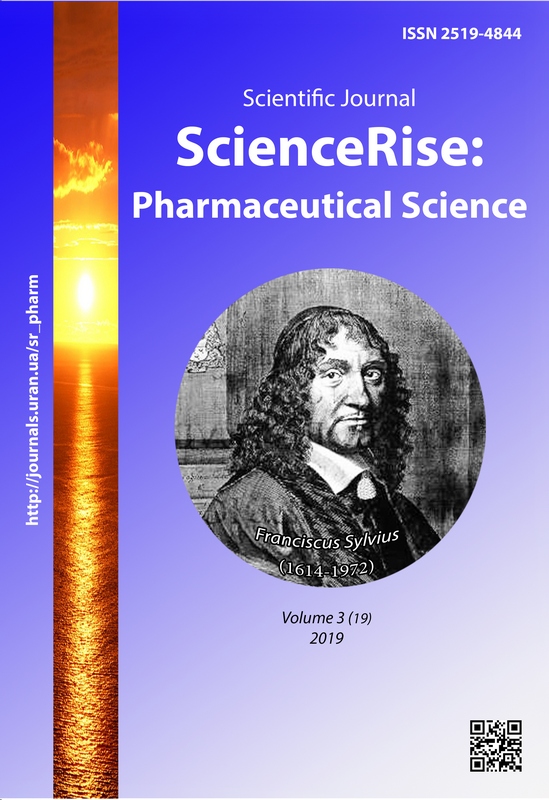Синтез потенційних антиексудативних засобів з ряду 2-((4-аміно-5-(фуран-2-іл)-1,2,4-тріазол(4Н)-3-іл)-сульфаніл)-N-ацетамідів
DOI:
https://doi.org/10.15587/2519-4852.2019.171878Ключові слова:
синтез, 4-аміно-3-тіо-5-(фуран-2-іл)-1, 2, 4-тріазол, ацетаміди, алкілування, антиексудативна активність, формаліновий набряк.Анотація
Мета. Провести цілеспрямований синтез нових потенційних біологічно-активних речовин похідних 2-((4-аміно-5-(фуран-2-іл)-1,2,4-тріазол(4Н)-3-іл)-сульфаніл)-N-ацетамідів та оцінити їх антиексудативну активність на моделі формалінового набряку у щурів.
Матеріали та методи. У роботі використовували стандартні методи органічного синтезу, фізико-хімічні методи доведення будови синтезованих сполук, елементний аналіз, 1H ЯМР-спектроскопію, хромато-мас-спектрометрію, антиексудативну активність вивчено на моделі формалінового набряку у щурів за допомогою цифрового плетизмометра.
Результати. Шляхом алкілування 2-((4-аміно-5-(фуран-2-іл))-4Н-1,2,4-тріазол-3-тіона N-арилзаміщеними α-хлорацетамідами в етанолі у лужному середовищі одержані відповідні 2-((4-аміно-5-(фуран-2-іл)-1,2,4-тріазол(4Н)-3-іл)-сульфаніл)-N-ацетаміди. Після кристалізації отримували білі або світло-жовті кристалічні речовини з чіткими температурами плавлення. На моделі формалінового набряку у щурів вивчили антиексудативну активність нових, синтезованих нами 2-((4-аміно-5-(фуран-2-іл)-1,2,4-тріазол(4Н)-3-іл)-сульфаніл)-N-ацетамідів. За результатами проведених досліджень встановлено залежність «хімічна структура – антиексудативна активність» вперше синтезованих сполук. Результати експериментальних досліджень показали, що п'ятнадцять із двадцять однієї сполуки виявили антиексудативну активність, вісім із них перевищували цю активність, або були на рівні референс-препарату – диклофенаку натрію.
Висновки. Здійснено синтез двадцяти однієї сполуки похідних 2-((4-аміно-5-(фуран-2-іл)-1,2,4-тріазол(4Н)-3-іл)-сульфаніл)-N-ацетамідів та проведено оцінку антиексудативної активності, встановлено залежність «хімічна структура – антиексудативна активність». Виявлено сполуки-лідери за актиексудативною активністю.
Посилання
- Ignatov, Iu. D., Kukes, V. G., Mazurov, V. I. (2010). Klinicheskaia farmakologiia nesteroidnykh protivovospalitelnykh sredstv. Moscow: GEOTAR, 258.
- Karateev, A. E. (2012). Primenenie NPVP: skhematicheskii podkhod. Russkii meditsinskii zhurnal, 25, 1558.
- Demetskaia, A. (2017). Nezhelatelnye lekarstvennye reaktsii: NPVP. Farmatsevt praktik, 2, 28–29.
- Küçükgüzel, Ş. G., Çıkla-Süzgün, P. (2015). Recent advances bioactive 1,2,4-triazole-3-thiones. European Journal of Medicinal Chemistry, 97, 830–870. doi: http://doi.org/10.1016/j.ejmech.2014.11.033
- Ferreira, V. F., da Rocha, D. R., da Silva, F. C., Ferreira, P. G., Boechat, N. A., Magalhães, J. L. (2013). Novel 1H-1,2,3-, 2H-1,2,3-, 1H-1,2,4- and 4H-1,2,4-triazole derivatives: a patent review (2008 – 2011). Expert Opinion on Therapeutic Patents, 23 (3), 319–331. doi: http://doi.org/10.1517/13543776.2013.749862
- Kharb, R., Sharma, P. C., Yar, M. S. (2010). Pharmacological significance of triazole scaffold. Journal of Enzyme Inhibition and Medicinal Chemistry, 26 (1), 1–21. doi: http://doi.org/10.3109/14756360903524304
- Tariq, S., Kamboj, P., Alam, O., Amir, M. (2018). 1,2,4-Triazole-based benzothiazole/benzoxazole derivatives: Design, synthesis, p38α MAP kinase inhibition, anti-inflammatory activity and molecular docking studies. Bioorganic Chemistry, 81, 630–641. doi: http://doi.org/10.1016/j.bioorg.2018.09.015
- Mousa, T. H., Elia, A. N. (2015). Design, synthesis and preliminary pharmacological evaluation of new possible non-steroidal anti-inflammatory agents having the 5-(methylsulfonyl)-1,2,4-triazole-3-amine pharmacophore. Der Pharma Chemica, 7 (9), 279–293.
- Shepeta, Y. L., Lelyukh, M. I., Zimenkovsky, B. S., Lesyk, R. B. (2016). Synthesis of novel 4H-1,2,4-triazole-3-thiol derivatives with 2-(2,6-dichlorophenylamino)benzyl fragment in molecules and their anti-inflammatory activity. Current Issues in Pharmacy and Medicine: Science and Practice, 1 (20), 18–25. doi: http://doi.org/10.14739/2409-2932.2016.1.61103
- Coşkun, G., Djikic, T., Hayal, T., Türkel, N., Yelekçi, K., Şahin, F., Küçükgüzel, Ş. (2018). Synthesis, Molecular Docking and Anticancer Activity of Diflunisal Derivatives as Cyclooxygenase Enzyme Inhibitors. Molecules, 23 (8), 1969. doi: http://doi.org/10.3390/molecules23081969
- Navidpour, L., Shafaroodi, H., Abdi, K., Amini, M., Ghahremani, M. H., Dehpour, A. R., Shafiee, A. (2006). Design, synthesis, and biological evaluation of substituted 3-alkylthio-4,5-diaryl-4H-1,2,4-triazoles as selective COX-2 inhibitors. Bioorganic & Medicinal Chemistry, 14 (8), 2507–2517. doi: http://doi.org/10.1016/j.bmc.2005.11.029
- Cai, H., Huang, X., Xu, S., Shen, H., Zhang, P., Huang, Y. et. al. (2016). Discovery of novel hybrids of diaryl-1,2,4-triazoles and caffeic acid as dual inhibitors of cyclooxygenase-2 and 5-lipoxygenase for cancer therapy. European Journal of Medicinal Chemistry, 108, 89–103. doi: http://doi.org/10.1016/j.ejmech.2015.11.013
- Jiang, B., Huang, X., Yao, H., Jiang, J., Wu, X., Jiang, S. et. al. (2014). Discovery of potential anti-inflammatory drugs: diaryl-1,2,4-triazoles bearing N-hydroxyurea moiety as dual inhibitors of cyclooxygenase-2 and 5-lipoxygenase. Organic & Biomolecular Chemistry, 12 (13), 2114–2127. doi: http://doi.org/10.1039/c3ob41936c
- Syrovaya, A. O., Chalenko, N. N., Demchenko, A. M. (2016). The Synthesis of potential anti-inflammatory substances among 4-amino-5-(pyridin-4-yl)-1,2,4-triazole(4H)-3-yl-thioacetamides and their chemical modification. Der Pharma Chemica, 8 (21), 17–21.
- Syrovaya, A., Chalenko, N., Bezuglyi, P., Demchenko, A. (2017). The synthesis of 4-amino -5-(pyridin-2(3)-Yl) -1,2,4-triazole (4H)-3-ylthio acetamide derivatives as potential anti-inflammatory substances. ScienceRise: Pharmaceutical Science, 1 (5), 40–44. doi: http://doi.org/10.15587/2519-4852.2017.93332
- Parchenko, V. V., Yerokhin, V. Ye., Panasenko, O. I., Knysh, Ye. H. (2010). Syntez, peretvorennia, fizyko-khimichni vlastyvosti 4-alkil-, aryl-ta 4-aminopokhidnykh 1,2,4-triazol-3-tioliv iz zalyshkamy frahmentiv furanu. Zaporozhskyi medytsynskyi zhurnal, 12 (4), 83–87.
- Xu, S., Rouzer, C. A., Marnett, L. J. (2014). Oxicams, a class of nonsteroidal anti-inflammatory drugs and beyond. IUBMB Life, 66 (12), 803–811. doi: http://doi.org/10.1002/iub.1334
- Rani, P., Pal, D., Hegde, R. R., Hashim, S. R. (2014). Anticancer, Anti-Inflammatory, and Analgesic Activities of Synthesized 2-(Substituted phenoxy) Acetamide Derivatives. BioMed Research International, 2014, 1–9. doi: http://doi.org/10.1155/2014/386473
- Saidov, N. B., Kadamov, I. M., Georgiyants, V. A., Taran, A. V. (2014). Planning, Synthesis, and Pharmacological Activity of Alkyl Derivatives of 3-Mercapto-4-Phenyl-5-Arylaminomethyl-1,2,4-Triazole-(4H). Pharmaceutical Chemistry Journal, 47 (11), 581–585. doi: http://doi.org/10.1007/s11094-014-1011-0
- Way2Drug – main. (Prediction of Activity Spectra for Substances) PASS. Available at: http://www.way2drug.com/PASSonline/
- Nadkarni, B., Kamat, V., Khadse, B. (2011). Synthesis and Anthelmintic Activity of 3,6-Disubstituted-7H-s-triazolo(3,4-b) (1,3,4) thiadiazines. Arzneimittelforschung, 51 (7), 569–573. doi: http://doi.org/10.1055/s-0031-1300081
- Drohovoz, S. M., Zupanets, I. A., Mokhort, M. A. (2001). Eksperymentalne (doklinichne) vyvchennia farmakolohichnykh rechovyn, yaki proponuiutsia yak nesteroidni protyzapalni zasoby. Doklinichni doslidzhennia likarskykh zasobiv. Kyiv: Avitsenna, 242–306.
- Rybolovlev, Iu. R., Rybolovlev, R. S. (1979). Dozirovanie veshchestv dlia mlekopitaiushchikh po konstantam biologicheskoi aktivnosti. Doklady AN SSSR, 6, 1513–1516
- Stefanov, O. V. (Ed.) (2001). Doklinichni doslidzhennia likarskykh zasobiv. Kyiv: Avitsenna, 527.
##submission.downloads##
Опубліковано
Як цитувати
Номер
Розділ
Ліцензія
Авторське право (c) 2019 Natalia Chalenko, Anatoly Demchenko, Ganna Syrova

Ця робота ліцензується відповідно до Creative Commons Attribution 4.0 International License.
Наше видання використовує положення про авторські права Creative Commons CC BY для журналів відкритого доступу.









